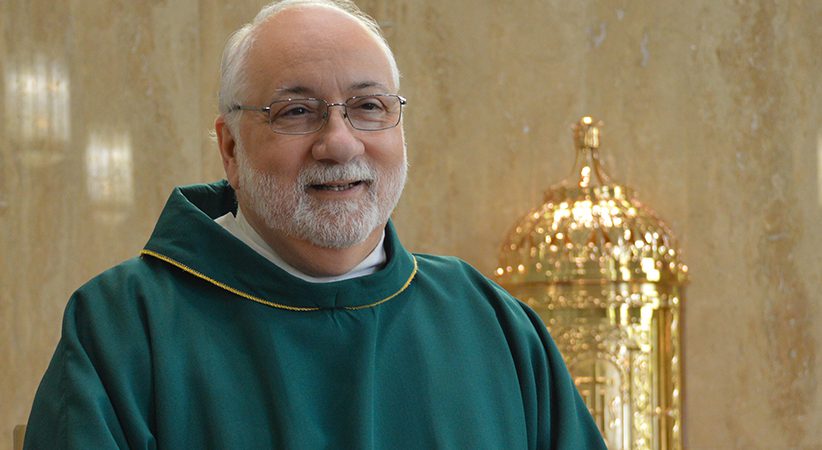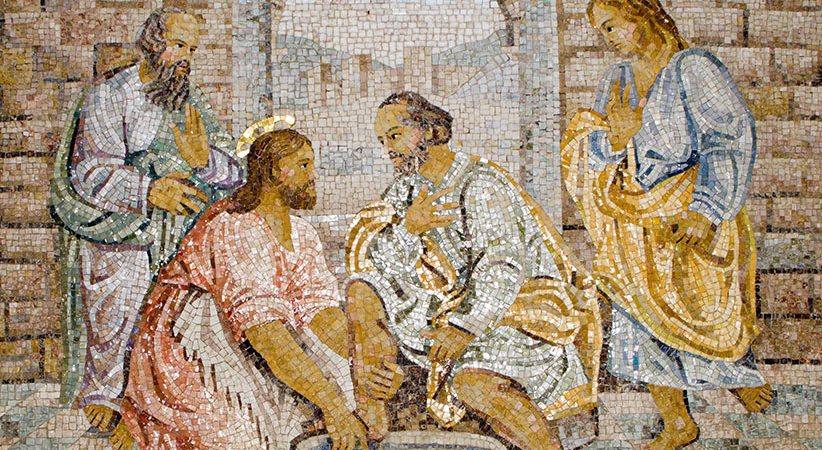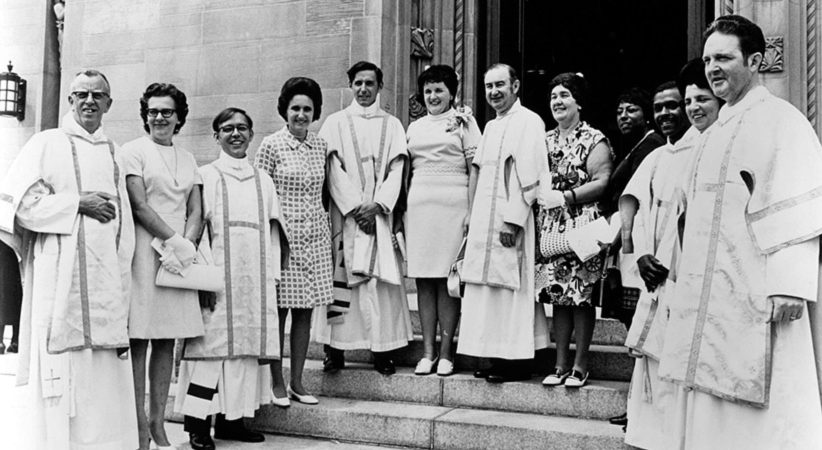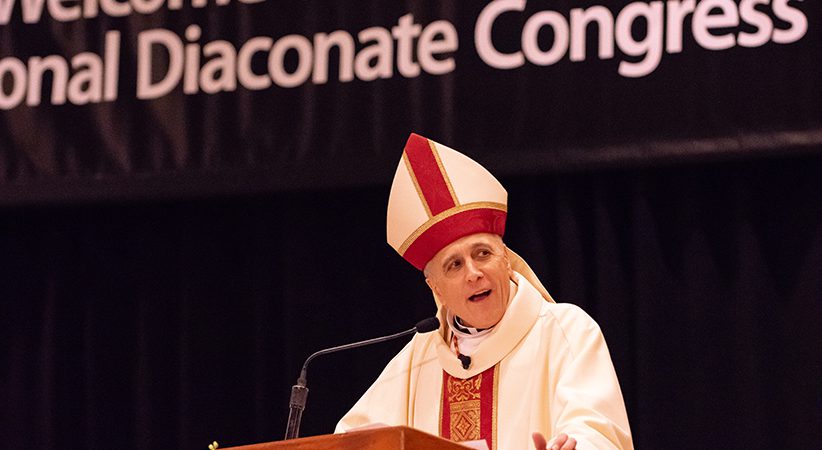Theology of the Body and Deacons
Understanding what it means to be made in the image and likeness of God
Janet Waring Comments Off on Theology of the Body and Deacons
Many have heard of Pope St. John Paul II’s Theology of the Body, shorthand for his book “Man and Woman He Created Them: A Theology of the Body” (Pauline Books and Media, $39.95). Remembering saints is often, in a way, a gift to answer the problems of the time. John Paul II is a great gift for our time. His Theology of the Body provides the language for deacons, and all Christians, to articulate a proper Christian anthropology and repropose the sacramental worldview of our post-Christian culture.
Deacons are often called to answer difficult questions on who the human person is, how to live the Gospel and what is the need for the Sacrament of Matrimony. Why are we made male and female? Do our bodies matter at all? Why not gay marriage and vasectomies? Why not in vitro fertilization (IVF) or contraception? John Paul II helps us understand what it means to be made in the image and likeness of a Trinitarian God of love who invites us into a relationship.
Trinitarian God of Love
The Trinity exists as a divine communion of persons, characterized by the mutual, self-giving love of the Father and the Son overflowing into the Holy Spirit. John Paul II’s definition of love is to be a gift, echoing the Second Vatican Council document Gaudium et Spes, “Man … cannot truly find himself, except through a sincere gift of himself” (No. 24).
This also explains why God provides Eve as a helpmate for Adam in Genesis 2. By himself, alone, among the animals, he could find no person to have a mutual exchange of self-giving love. In one of John Paul II’s first audiences to discuss this theology, he presents it this way: “Man became the ‘image and likeness’ of God not only through his own humanity, but also through the communion of persons which man and woman form from the very beginning. The function of the image is to reflect the one who is the model, to reproduce its own prototype. Man becomes an image of God not so much in the moment of solitude as in the moment of communion” (General Audience, Nov. 14, 1979).

If man and woman image a Trinitarian God of love, they must be able to form a union and communion of love that has the potential to burst forth in a third person that bears the image of love between the two. In biblical language, we hear: “That is why a man leaves his father and mother and clings to his wife, and the two of them become one body. The man and his wife were both naked, yet they felt no shame” (Gn 2:24-25).
Male and female are two incarnations of the human person, what John Paul II calls the “unity of the two”; they share a common human nature with distinct feminine and masculine attributes, that contains from the beginning the spousal attribute, “the capacity of expressing love, that love in which the person becomes a gift and — by means of this gift — fulfills the meaning of his being and existence” (General Audience, Jan. 16, 1980).
The woman, as bride, has a distinctive feminine receptivity, which is written into her body, in the anatomy of her womb, and in the structure of her arms to carry infants close to the heart. The male body anatomically shows its movement outward sexually and anatomically in the structure of the arms for outward movement. Adam and Eve had divine vision and could see the meaning and purpose of their bodies, to be a mutual gift in love, body and soul. They welcome and affirm each other as a gift (cf. General Audience, Jan. 16, 1980).
Adam and Eve, in their union and communion, as husband and wife become one, a “we-person,” with the potential to conceive a child, who bears the physical image of the two. Potential fruitfulness and mutual receptivity inside the sacramental marital embrace is a requirement to image the divine family, its prototype. This requirement for openness to children, spoken with the marital vow to accept children lovingly, adequately answers why gay marriage and contraception cannot be sacramental. Surrogacy and IVF are conceptions outside the marital embrace, or one-flesh union, and may sometimes require a third person.
Marriage
Marriage in accord with the vows of freedom, fidelity to death and openness to life in a one-flesh union becomes a physical sign in the created order of an invisible reality, a sacramental sign of Trinitarian love, the divine family of love it images (cf. Catechism of the Catholic Church, No. 2205).
Jesus raises marriage to the level of a sacrament in the Church so that the husband and wife can receive grace to live the demands of self-giving love, which exceeds our human capabilities.
John Paul II teaches the “body expresses the person” (General Audience, Oct. 31, 1979). The body is integral to who we are as human persons, not a costume to be set aside. We are doers of the Word and believe in the resurrection of our bodies, a new divinized reality in heaven. Sadly, because of the Fall, we can “lie” with the language of the body, misusing our bodies with alcohol, drugs, extramarital sex, pornography and trafficking — acts all contrary to love.
John Paul II examines the cosmic catastrophe of the Fall, and the effects of the broken relationship with the Father: “The man who gathers the fruit of the ‘tree of the knowledge of good and evil’ makes, at the same time, a fundamental choice. … Man turns his back on God-Love, on the Father. He in some sense casts him out of his heart, … cuts it off from what ‘is of the Father.’ Thus, there remains in him what ‘is of the world’” (General Audience, April 30, 1980).
The covenant relationship with his loving Father is broken by original sin, and the human person becomes a person of concupiscence. All other relationships fall as well: Man’s relationship with the woman, and other human persons disintegrate. The human body is subject to death and disease, and man is tempted to conquer nature, rather than be its steward. Finally, man experiences internal division, a divided heart (cf. Rom 7:18-20).
Fallen man lacks self-mastery; his passions and emotions often hijack his heart. Rather than building a civilization of love, the man of concupiscence builds a civilization of use, acting for self-advantage, not self-giving love. The baptized man who loses his relationship with the Father will weaken his identity in Christ, reduce his freedom to love and cloud his mission. A return to prayer and the sacramental life restores the identity in Christ and he person’s proper mission as husband/father, deacon or wife/mother.
Preaching Marriage
As deacons you will be called to preach on marriage, but more important to many young people who grow up without their biological father in the home, you are to be the icon of Christ the Servant as a husband and father.
In the discussion on marriage, John Paul II explains how the language of the body has a two-fold covenant analogy in Ephesians 5. When Paul refers to the mystery of spousal love meaning Christ and his Church, he connects the Sacrament of Matrimony and the Sacrament of the Eucharist.
The spousal language of the body of Jesus is transformed into the language of the liturgy, just as the couple comes freely to the Sacrament of Matrimony, and offer themselves faithfully till death, with an openness to children. So, too, Jesus the bridegroom comes freely to the cross, offers himself totally til death, and the sacraments of blood and water pour forth fruitfully from his side.
In the words of Augustine: “He came to the marriage bed of the Cross, and there in mounting it, he consummated his marriage … he lovingly gave himself up to the torment in place of his bride and joined himself to her forever.” (Sermo Suppositus, No. 120)
Jesus is the ultimate example of total, faithful and fruitful self-giving love of the Bridegroom for his Bride. He is the true image of the primordial sacrament of marriage in Genesis. He is the new Adam, fully revealing “man to himself” (Gaudium Et Spes, No. 22). In the Sacrament of the Eucharist, his bride receives him, her bridegroom in a union and communion of total, reciprocal, self-giving love.
The deacon and his wife are called to speak the truth of marriage in their bodies and build a sacramental Catholic family, a domestic church, a mini-Communion of Saints. A proper understanding of Jesus the Bridegroom and his love for his Bride, as the icon of true freedom lived in self-giving love, needs to be seen and taught to a culture that rejects the Father, sees the body as dispensable, defines freedom as license and runs from the demands of marital love.
It has been said George Weigel saw/sees the Theology of the Body as a “ticking time bomb” ready to go off in the Church. Perhaps, deacons need to light the fuse.
JANET WARING and Deacon Randy Waring help with marriage preparation for the Diocese of Joliet. Janet has a master’s degree in theology from Franciscan University and did a two-year certification in Theology of the Body through the John Paul II Institute for Theology of the Body and Culture in the Diocese of Phoenix.
……………………………………………………………………………………………………………………………………………
Learn More from the Master
Learn more about the Theology of the body from the master himself, Pope St. John Paul II in “Man and Woman He Created Them: Theology Of The Body” (Pauline Books and Media, $39.95). The book is a seminal work on the bodily dimension of human personhood, sexuality, marriage, and celibacy. First written while he was archbishop of Kraków, in Poland, then later revised and delivered as a series of catecheses after he became pope, this work was called Theology of the Body by John Paul II himself. In his momentous teaching, John Paul has left us the core of his great vision, focused on the mystery of love extending from the Trinity, through Christ’s spousal relation with the Church, to the concrete bodies of men and women.
……………………………………………………………………………………………………………………………………………





